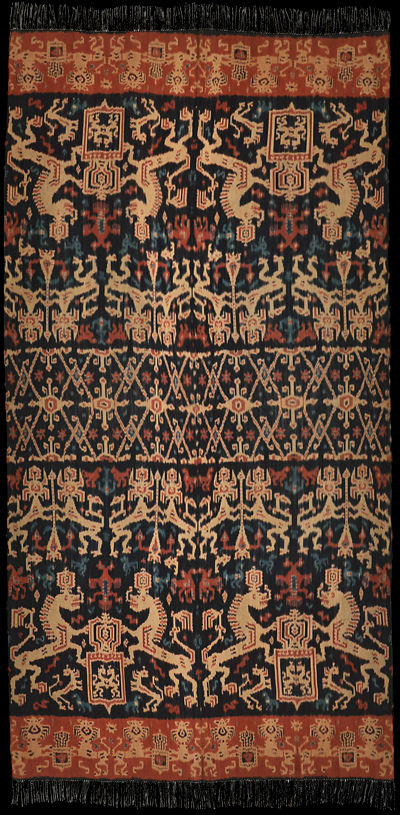| |
 
 | | | |
364 Sumba, East Sumba
Hinggi (men's blanket)
| | Locale: | Melolo | | Period: | 1930-1935 | | Yarn: | Cotton, commercial, fine, double-ply | | Technique: | Warp ikat | | Panels: | 2 | | Size: | 123 x 248 cm (4' 0" x 8' 1") LW: 2.02 | | Weight: | 880 g (31.0 oz), 288 g/m2 (0.94 oz/ft2) | | Design: | Apart from tiny fowl, snakes and other zoomorphic fillers, the only motifs in this hinggi are mounting lions, no doubt a manifestation of the role this cloth was intended to play, to wit that of a diplomatic instrument (see below), with powerful heraldic significance. The design shows the same characteristics as several known Melolo hinggi from the earlier part of the 20th century. A 7-band design builds up from the extremities with a narrow red band carrying with 8 small animals; a wide ikated band with four big animals; a secondary ikated band with 8 animals; all leading up to and a starry, usually patola-inspired kundu duku. The patterning of this particular midsection, was inspired by a patola of the Vohra Galji Bhat design. The subtle keys hidden in the kundu duku which both create and reveal axial asymmetry, make clear that the intent was to create a truly high class present. | | Comment: | This cloth was made in commission for the Dutch colonial government, to be presented to a member of the British aristocracy. It therefore deviates from what would have been made for the local nobles. It would not be suitable for funerals and other adat use, but is a fine example of what high-end dyers were of the time were capable of. The piece ended up in the Petter collection (Jakarta) then via an inheritance sale returned to Sumba, whence it found its way to the Pusaka Collection. It attracted attention not just by the subtle design of the hidden keys which create axial asymmetry, but also by its powerful presence and the overaverage alignment of the warp yarns, which yields drawing with good definition. | | Background: | Chapters on Sumba and East Sumba. | | Published: | Ikat from Timor and its Outer Islands, 2022.
Noble Virtuosity: Hidden Asymmetry in Ikat from Sumba, 2024. | | |

©Peter ten Hoopen, 2025
All rights reserved.
|
|


